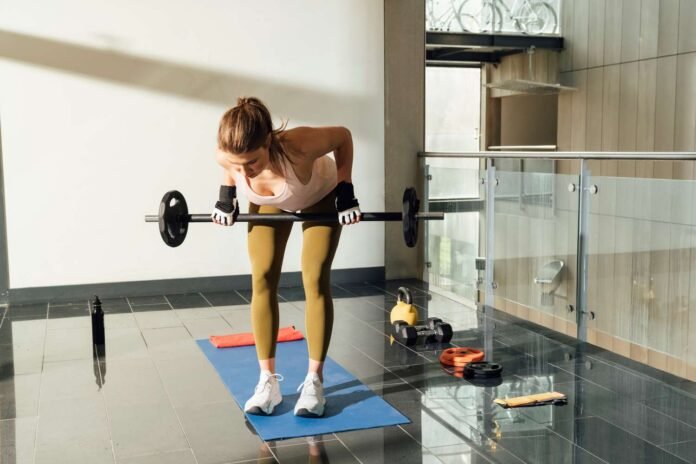For many, lifting weights is a key part of their fitness routine, but it can come with unexpected skincare challenges. According to Dr. Konidena, exposure to various irritants and allergens during physical activity can lead to skin problems such as contact dermatitis. The combination of mechanical stress, increased sweating, and elevated temperatures from intense workouts can cause small breaks, fissures, and abrasions in the skin, leading to irritation.
Dr. Konidena emphasizes the importance of wearing high-quality gym attire that effectively absorbs moisture. Moisture-wicking fabrics help prevent excessive sweating from settling on the skin, which can reduce the risk of irritation and fungal infections. “When gym wear does not wick away sweat, it can create a breeding ground for bacteria and fungi, increasing the likelihood of skin issues,” she explains.
Additionally, many weightlifters avoid using gloves, which can lead to hardened skin on their palms. Over time, this can cause discomfort and even pain. Calluses are a common result of frequent lifting without proper hand protection. While some might view calluses as a badge of honor, they can become painful and lead to more significant skin problems if not managed properly.
Sharing gym equipment also poses a risk for fungal infections. Gyms are communal spaces where equipment is used by many people, and pathogens can easily spread. Dr. Konidena advises taking precautions, such as using personal gym towels and cleaning equipment before and after use. “Fungal infections can be a serious issue in shared spaces, and simple steps like these can help prevent them,” she says.
Maintaining proper hygiene is another crucial aspect of preventing skin problems. Showering immediately after a workout and changing out of sweaty gym clothes can help remove sweat and bacteria from the skin. Using a gentle cleanser can also aid in keeping the skin clean and free from irritants.
Dr. Konidena also highlights the importance of moisturizing the skin after workouts. “Many people overlook the benefits of moisturizing,” she says. “After exposure to sweat and mechanical stress, the skin needs to be replenished with hydration to help repair and protect it.”
In cases where skin issues arise despite taking precautions, Dr. Konidena recommends seeking medical advice. Persistent irritation or infections should be evaluated by a dermatologist to ensure proper treatment and prevent further complications.
Overall, while lifting weights can be beneficial for fitness, it is essential to pay attention to skincare. By wearing appropriate gym wear, using gloves, maintaining hygiene, and moisturizing, individuals can reduce the risk of skin problems associated with weightlifting.
By addressing these common skincare blunders, gym-goers can enjoy their workouts without compromising their skin health.
When it comes to gym skincare, prevention is better than cure. Dr. Konidena suggests that gym-goers should also consider the quality of the gym equipment they use. Many people overlook the fact that shared equipment can harbor germs and bacteria. Regularly cleaning and disinfecting gym equipment, and using personal mats or grips, can further minimize the risk of skin issues.
Another factor to consider is the type of detergent used for washing gym wear. Dr. Konidena notes that harsh chemicals in some detergents can exacerbate skin sensitivities. Opting for hypoallergenic or fragrance-free laundry detergents can reduce the risk of irritation, particularly for those with sensitive skin.
The environment in which one works out also plays a role. Gyms that are poorly ventilated can contribute to excessive sweating and discomfort. Ensuring that workout spaces are well-ventilated and maintaining a clean gym environment can help in reducing the buildup of sweat and bacteria on the skin.
Diet can also impact skin health. Dr. Konidena points out that a diet high in processed foods and sugar can lead to skin inflammation and breakouts. A balanced diet rich in vitamins and antioxidants supports overall skin health and can help the skin recover more effectively from the stresses of weightlifting.
Rest and recovery are crucial aspects of fitness that are often overlooked. Adequate sleep and recovery time allow the skin to repair itself. Dr. Konidena emphasizes that proper rest contributes to the body’s ability to heal and regenerate, which includes repairing any skin damage caused by workouts.
For those who notice persistent skin issues despite taking these precautions, consulting with a dermatologist or a skincare specialist is advisable. They can provide tailored advice and treatment options to address specific concerns related to gym workouts and skin health.
Ultimately, maintaining a comprehensive approach to skincare, including proper gym wear, hygiene practices, diet, and recovery, can help mitigate the risk of skin problems. By incorporating these strategies, individuals can ensure that their fitness routines do not come at the expense of their skin health.
